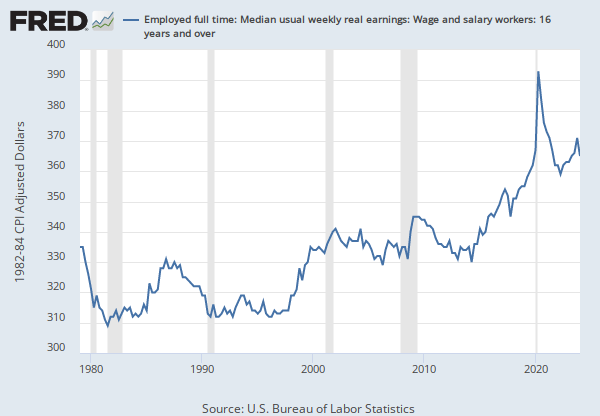Federal Reserve Economic Data
- Release Calendar
- FRED Tools
- FRED News
- FRED Blog
- About FRED
Data in this graph are copyrighted. Please review the copyright information in the series notes before sharing.
NOTES
Source: U.S. Bureau of Labor Statistics
Source: Federal Reserve Bank of St. Louis
Release: State and Metro Area Employment, Hours, and Earnings
Units: Dollars per Hour, Seasonally Adjusted
Frequency: Monthly
Notes:
This series is discontinued and will no longer be updated. The Federal Reserve Bank of St. Louis previously calculated this seasonally adjusted (SA) series based on the not seasonally adjusted (NSA) version available here. However, most of the earnings-related series do not have a significant seasonal component, so the values for both the SA and the NSA series are very similar. See the NSA series for updated values.
The Federal Reserve Bank of St. Louis previously used to seasonally adjust this series by using the 'statsmodels' library from Python with default parameter settings. The package uses the U.S. Bureau of the Census X-13ARIMA-SEATS Seasonal Adjustment Program. More information on the 'statsmodels' X-13ARIMA-SEATS package can be found here. More information on X-13ARIMA-SEATS can be found here.
Many series include both seasonally adjusted (SA) and not seasonally adjusted (NSA) data. Occasionally, updates to the data will not include sufficient seasonal factors to trigger a seasonal adjustment. In these cases, the NSA series will be updated normally; but the SA series will also be updated with the NSA data. The NSA series can be located here here.
Some seasonally adjusted series may exhibit negative values because they are created from a seasonal adjustment process regardless of the actual meaning or interpretation of the given indicator.
Suggested Citation:
U.S. Bureau of Labor Statistics and Federal Reserve Bank of St. Louis, Average Hourly Earnings of All Employees: Total Private in Wichita, KS (MSA) (DISCONTINUED) [SMU20486200500000003SA], retrieved from FRED, Federal Reserve Bank of St. Louis; https://fred.stlouisfed.org/series/SMU20486200500000003SA, .
Source: U.S. Bureau of Labor Statistics
Source: Federal Reserve Bank of St. Louis
Release: State and Metro Area Employment, Hours, and Earnings
Units: Dollars per Hour, Seasonally Adjusted
Frequency: Monthly
Notes:
This series is discontinued and will no longer be updated. The Federal Reserve Bank of St. Louis previously calculated this seasonally adjusted (SA) series based on the not seasonally adjusted (NSA) version available here. However, most of the earnings-related series do not have a significant seasonal component, so the values for both the SA and the NSA series are very similar. See the NSA series for updated values.
The Federal Reserve Bank of St. Louis previously used to seasonally adjust this series by using the 'statsmodels' library from Python with default parameter settings. The package uses the U.S. Bureau of the Census X-13ARIMA-SEATS Seasonal Adjustment Program. More information on the 'statsmodels' X-13ARIMA-SEATS package can be found here. More information on X-13ARIMA-SEATS can be found here.
Many series include both seasonally adjusted (SA) and not seasonally adjusted (NSA) data. Occasionally, updates to the data will not include sufficient seasonal factors to trigger a seasonal adjustment. In these cases, the NSA series will be updated normally; but the SA series will also be updated with the NSA data. The NSA series can be located here here.
Some seasonally adjusted series may exhibit negative values because they are created from a seasonal adjustment process regardless of the actual meaning or interpretation of the given indicator.
Suggested Citation:
U.S. Bureau of Labor Statistics and Federal Reserve Bank of St. Louis, Average Hourly Earnings of All Employees: Total Private in Kansas (DISCONTINUED) [SMU20000000500000003SA], retrieved from FRED, Federal Reserve Bank of St. Louis; https://fred.stlouisfed.org/series/SMU20000000500000003SA, .
Source: U.S. Bureau of Labor Statistics
Release: Employment Situation
Units: Dollars per Hour, Seasonally Adjusted
Frequency: Monthly
Notes:
The series comes from the 'Current Employment Statistics (Establishment Survey).'
The source code is: CES0500000003
The Average Hourly Earnings of All Private Employees is a measure of the average hourly earnings of all private employees on a “gross” basis, including premium pay for overtime and late-shift work. These differ from wage rates in that average hourly earnings measure the actual return to a worker for a set period of time, rather than the amount contracted for a unit of work, the wage rate. This measure excludes benefits, irregular bonuses, retroactive pay, and payroll taxes paid by the employer.
Average Hourly Earnings are collected in the Current Employment Statistics (CES) program and published by the BLS. It is provided on a monthly basis, so this data is used in part by macroeconomists as an initial economic indicator of current trends. Progressions in earnings specifically help policy makers understand some of the pressures driving inflation.
It is important to note that this series measures the average hourly earnings of the pool of workers in each period. Thus, changes in average hourly earnings can be due to either changes in the set of workers observed in a given period, or due to changes in earnings. For instance, in recessions that lead to the disproportionate increase of unemployment in lower-wage jobs, average hourly earnings can increase due to changes in the pool of workers rather than due to the widespread increase of hourly earnings at the worker-level.
For more information, see:
U.S. Bureau of Labor Statistics, CES Overview
U.S. Bureau of Labor Statistics, BLS Handbook of Methods: Chapter 2. Employment, Hours, and Earnings from the Establishment Survey
Suggested Citation:
U.S. Bureau of Labor Statistics, Average Hourly Earnings of All Employees, Total Private [CES0500000003], retrieved from FRED, Federal Reserve Bank of St. Louis; https://fred.stlouisfed.org/series/CES0500000003, .


































